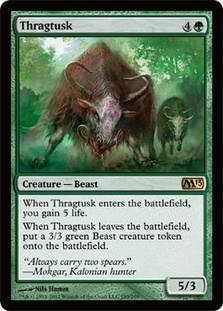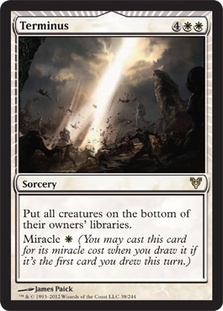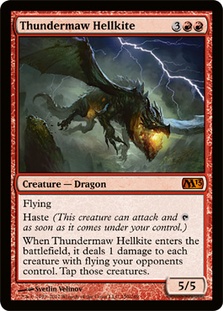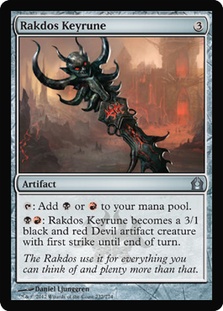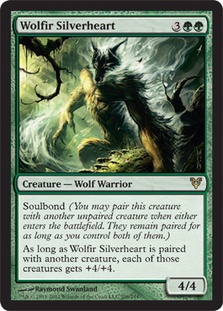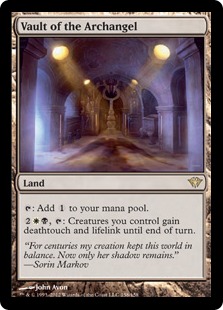I’ve spent some time here in the past raging on times in Standard when a particular card or strategy seems to be dominant or all over the place—Jace, the Mind Sculptor and Delver of Secrets spring to mind—and not too long ago someone threw that back in my face, wondering why I wasn’t complaining about Thragtusk seeing as how it has been either the #1 or close to #1 pillar of the format since he appeared in Standard this summer.
I countered by saying I do complain about Thragtusk, but my complaint isn’t his existence so much as his casting cost. I’d have been much happier if he cost 2GGG to cast rather than 4G so that he’d be very much a green metagame weapon rather than something you can so easily splash into any/every deck you want.
"So you’d like Thragtusk better if he was worse?" was the reply.
Yeah. Kinda, sorta.
Or…maybe not.
I started pondering whether or not Wizards will reprint Thragtusk in Magic 2014. I mean, obviously they won’t, right? It’s just way too powerful…but is it unhealthy for the metagame? Despite grumblings from people about the omnipresence of Thragtusk (among a few other cards), the general consensus seems to be that we’ve got one of the most fun, interesting, balanced, and diverse Standard metagames in ages.
Which makes me wonder: how much of this wonderful metagame is actually due to Thragtusk? Is Thragtusk the miracle glue that’s holding all these wonderful things together?
I decided it might be a good thought exercise to work through all the things that a Thragtusk-heavy Standard gives us.
Playing Into Removal
Ever since I first started playing Magic, I loved playing creatures. LOVED it. But what I didn’t love was just how frickin’ hard it was to keep them on the board once they made it there. For the first age of Magic, removal was king, but Wizards eventually realized that making creatures better and removal worse made for a better game, so here we are in the modern age with Magic’s popularity is booming. Nearly every style of deck leans heavily on creatures, which also makes creature removal a necessity.
In fact, good creature sweepers have become even more valuable, and thus we get into that age-old game of cat and mouse. Do I put more pressure on the board to try to end the game faster, or do I keep cards in reserve to avoid getting blown out by one spell? When playing against control decks it’s often quite difficult to make the correct call because they typically have so many instant speed options, whereas if you’re playing a bunch of creatures you’re often stuck making critical decisions during your own main phase.
It’s the reason I love the undying creatures so much! You can apply additional pressure without risking getting blown out by a sweeper. In fact, the undying creature gets even bigger to help make up for any other creatures you had that got whisked away to the graveyard.
But then they printed Terminus, which is certainly one of the most devastating removal spells ever printed. Man, was I upset about that card. All the great abilities and cards that helped creature decks maneuver around mass removal—undying, indestructible, regeneration, persist—Terminus laughs at all of them. I was actually pretty down about Magic after that card was printed (Tales of Woe Is Me)…
Luckily the balm to sooth my heartsick soul came in the very next set: Thragtusk! One way to try to work around Terminus is to play value creatures with enters-the-battlefield abilities so that even if you have put them on the bottom of your deck, you’ve still gotten something from them. Thragtusk gives you a great life boost right off the bat, and then when it leaves play, it leaves behind a not-insignificant friend, a 3/3 beast token. I love that R&D worded it just right—leaves play—rather than dies, giving it value not only against Terminus but bounce spells as well.
Slowing Down Aggro
One of the more frustrating things in Magic is when your early game unfolds sub-par while your opponent gets their nut draw. Magic has a pretty huge random factor, and this sort of thing just happens even with the best deckbuilding and mulligan decisions. These are the sort of "free wins" that’s a huge reason to want to play aggro…but for the rest of us, it can be a huge downer to "lose to randomness."
A card like Thragtusk gives us hope that we can climb back into such a game. It’s by no means assured—sometimes games can just be over by the time you get to five mana—but if you can survive to five mana, you get a significant life boost and a significant body on the battlefield that’s resistant to removal. We’ve all been on the back foot to an aggressive draw, and few things make you feel better than slapping down Thragtusk and feeling pretty confident you’ve stabilized your position.
Making Creature Abilities Matter
Another great thing about Thragtusk is how much it’s made creature abilities better. One of the first questions a deck designer has to answer when building his deck is how do I handle Thragtusk? The answer often lies in other creatures and their abilities.
Flying: One answer is to ignore Thragtusk and take to the sky. A big reason why Falkenrath Aristocrat and Thundermaw Hellkite are so good is because they fly right over that guy and smash your opponent in the face. It’s easier to race to the win when you don’t need to slog through Thragtusks on the ground. This has the further effect of making reach a relevant ability.
First Strike: The Keyrune cycle is pretty sweet, but the reason why Rakdos Keyrune stands head and shoulders above the rest is because it’s perfectly crafted to handle Thragtusk. A 3/1 first striker kills Thragtusk and the 3/3 it leaves behind, all without losing a card. That’s pretty amazing! But would it be nearly so good in a world without Thragtusk?
Regeneration: Some folks have been coming around to see the value of Wolfir Avenger (notably Brian Kibler), one of the all-too-rare green creatures with flash, and a big reason is because of how well he handles Thragtusk. Just like Rakdos Keyrune, Wolfir Avenger handles both Thragtusk and the 3/3 it leaves behind without losing a card.
Trample: Thragtusk is particularly well suited to gaining trample with its five power, but it’s also rather bad at soaking up trample damage with its three toughness…so both sides of Thragtusk makes a card like Rancor that gives trample even better.
Rewards Thinking Outside the Box
Of course, sometimes the deck you’re building needs some other answer to a creature as good and as difficult to deal with as Thragtusk. In those cases, it pays to think outside the box. Sometimes, if you can’t beat ’em, you join ’em by playing Clone or Evil Twin. There are permanent-based removal spells that can neutralize but don’t actually remove Thragtusk from the board that have seen some play.
Crippling Blight was effective in aggressive black-based strategies, and I believe even Patrick Chapin has talked about considering Pacifism. Might Marshall Law see some play? Mark of Mutiny has shown up in some of the more aggressive B/R Zombies decks as a one-shot way to bring Thragtusk over to your side, and if you’ve got Falkenrath Aristocrat in play to sacrifice it afterwards, you get the 3/3.
Thankfully Not a Mythic
One thing we should all be particularly thankful for is the decision to not make Thragtusk a mythic rare. I think back to the difficulty and financial pain of acquiring mythic Lotus Cobras for my decks shortly after Zendikar was released. Yes, Thragtusk is still quite a pricey card even at rare (currently selling for around 25 bucks), but can you imagine what it would be going for if it were mythic?
Many of us could tell it was going to be a card we’d want four of early on and hopefully nabbed some copies—I preordered a playset at seven bucks a piece. But even if you were a late adopter and need to acquire them now, just be glad it’s just a rare… I shudder to speculate what the price point would be at mythic.
The Downside
One big problem with Thragtusk being so good (and so splashable) is how difficult it is to justify playing anything else at that point in the mana curve. And there are some really good alternatives: just in green we’ve got Wolfir Silverheart and Garruk, Primal Hunter that would otherwise easily be maindeckable at three or four copies. Silklash Spider is rather high tech right now against some of the powerhouse cards of the format (Falkenrath Aristocrat, Thundermaw Hellkite, Angel of Serenity), but after you’ve got your playset of Thragtusk, you can’t really run too many more fives. And how about the awesome Acidic Slime? That’s not even on anyone’s radar anymore!
On balance, though, I think it’s pretty clear that Standard has a better metagame due to the existence of Thragtusk, and I hope he makes a few more appearances in core sets, if not just becoming an evergreen staple. What do you think?
Speaking of Thragtusk, I want to share the deck I’ve been testing recently, which has been promising. It evolved from my Séance deck. It occurred to me that especially since I’d moved away from the Reanimator theme—using Séance just as a way to reuse my value creatures—that Angel of Serenity could give me enough power to reuse the value creatures while also being flexible enough to be good in the face of graveyard hate (while Séance is not). Swapping out Séance for Restoration Angel seemed like a big upgrade, giving some much-needed flying defense while also providing some great leverage against control decks with the flash ability. I also swapped in Wolfir Avenger to continue with the flash theme while also standing up to removal and fighting Thragtusk (as noted above).
The big breakthrough I think was Ulvenwald Tracker, which gives you a good early play and some much needed reusable removal. He’s particularly good with Wolfir Avenger, let’s you "ping" off something small with Elvish Visionary, and lets Thragtusk or Angel of Serenity chew up a potential chump blocker before rumbling into the red zone.
I splashed black because it was relatively easy, allowed for some additional removal, and made Vault of the Archangel possible, a card that has proven to be just fantastic in this deck. The threat of deathtouch can let your smaller guys keep attacking even if your opponent has tried to stabilize with larger creatures, and the lifelink really helps with racing. In one game I even had enough mana to activate the Vault and Silklash Spider for one to sweep all fliers from the skies.
Avacyn’s Pilgrim and Deathrite Shaman keep swapping places, and I’m not sure which is better, though right now I’m leaning towards Deathrite Shaman.
Creatures (28)
- 1 Silklash Spider
- 4 Elvish Visionary
- 4 Restoration Angel
- 4 Wolfir Avenger
- 4 Ulvenwald Tracker
- 4 Thragtusk
- 3 Angel of Serenity
- 4 Deathrite Shaman
Planeswalkers (2)
Lands (24)
Spells (6)

I’ve been considering dropping the black and perhaps going with Nightshade Peddler or possibly even Deadly Recluse to help with Ulvenwald Tracker fights. That would also let me work Predator Ooze into the mix. What do you think?
Can you believe Christmas is just two weeks away? Boy how time flies!
Take care,
Bennie
starcitygeezer AT gmail DOT com
Make sure to follow my Twitter feed (@blairwitchgreen). I check it often so feel free to send me feedback, ideas, and random thoughts. I’ve also created a Facebook page where I’ll be posting up deck ideas and will happily discuss Magic, life, or anything else you want to talk about!
New to Commander?
If you’re just curious about the format, building your first deck, or trying to take your Commander deck up a notch, here are some handy links:
- Commander Primer Part 1 (Why play Commander? Rules Overview, Picking your Commander)
- Commander Primer Part 2 (Mana Requirements, Randomness, Card Advantage)
- Commander Primer Part 3 (Power vs. Synergy, Griefing, Staples, Building a Doran Deck)
- Commander Starter Kits 1 (kick start your allied two-color decks for $25)
- Commander Starter Kits 2 (kick start your enemy two-color decks for $25)
- Commander Starter Kits 3 (kick start your shard three-color decks for $25)
My current Commander decks (and links to decklists):
- Karador, Ghost Chieftain (my Magic Online deck)
- Karona, False God (Vows of the False God)
- Skullbriar, the Walking Grave (how big can it get?)
- Phage the Untouchable (actually casting Phage from Command Zone!)
- Johan (Cat Breath of the Infinite)
- Niv-Mizzet, the Firemind (Chuck’s somewhat vicious deck)
Previous Commander decks currently on hiatus:
- Yeva, Nature’s Herald (living at instant speed)
- Nefarox, Overlord of Grixis (evil and Spike-ish)
- Niv-Mizzet, Dracogenius (new player-friendly)
- Trostani, Selesnya’s Voice (new player-friendly)
- Jarad, Golgari Lich Lord (drain you big time)
- Riku of Two Reflections (steal all permanents with Deadeye Navigator + Zealous Conscripts)
- Phelddagrif (Mean Hippo)
- Sigarda, Host of Herons (Equipment-centric Voltron)
- Bruna, Light of Alabaster (Aura-centric Voltron)
- Ruhan of the Fomori (lots of equipment and infinite attack steps)
- Ghave, Guru of Spores (Melira Combo)
- Glissa, the Traitor (undying artifacts!)
- Grimgrin, Corpse-Born (Necrotic Ooze Combo)
- Damia, Sage of Stone (Ice Cauldron shenanigans)
- Geist of Saint Traft (Voltron-ish)
- Glissa Sunseeker (death to artifacts!)
- Jor Kadeen, the Prevailer (replacing Brion Stoutarm in Mo’ Myrs)
- Thelon of Havenwood (Campfire Spores)
- Melira, Sylvok Outcast (combo killa)
- Konda, Lord of Eiganjo (The Indestructibles)
- Vorosh, the Hunter (proliferaTION)
- Progenitus (Fist of Suns and Bringers)
- Savra, Queen of the Golgari (Demons)
- Uril, the Miststalker (my "more competitive" deck)

